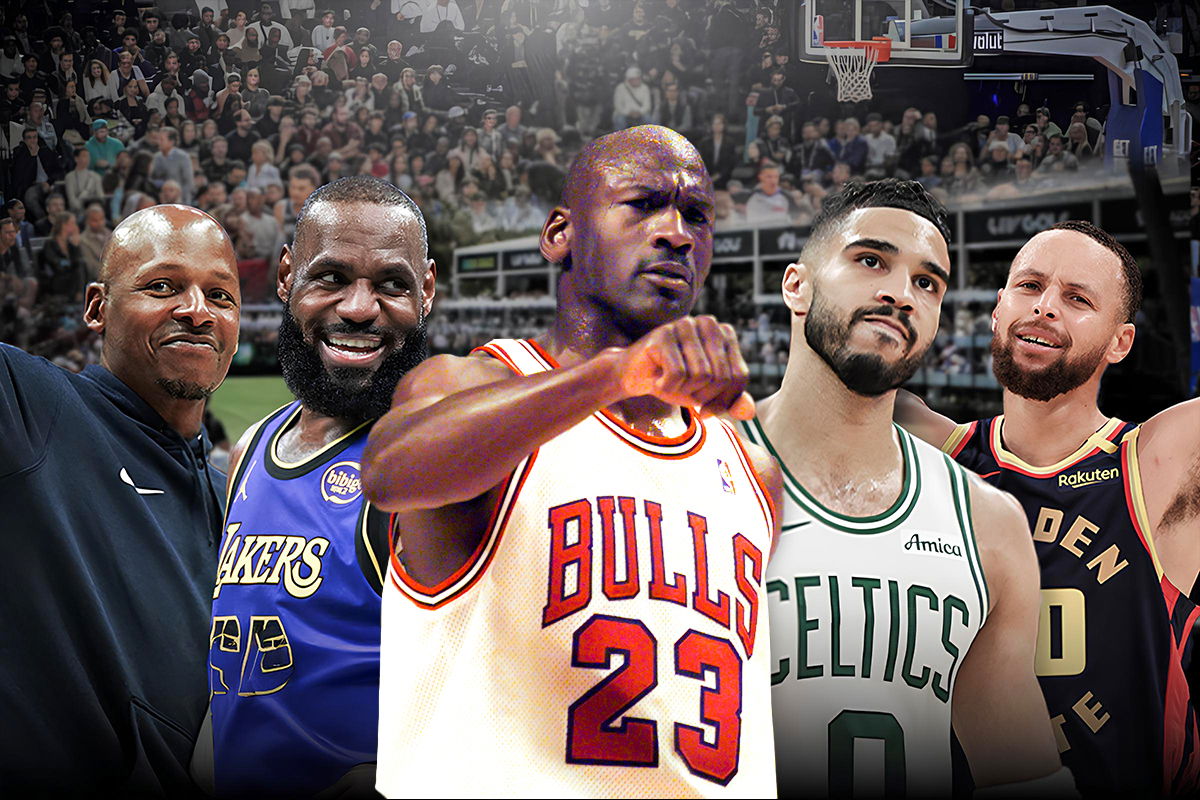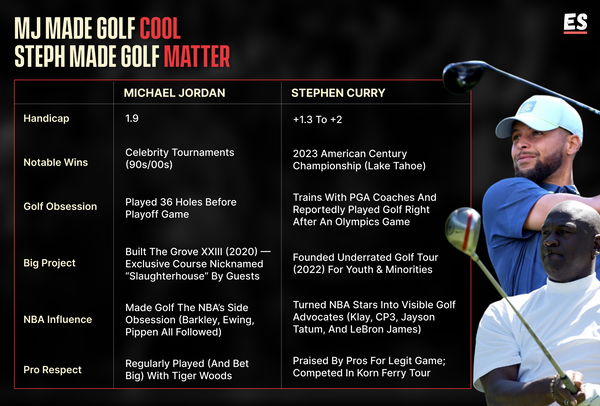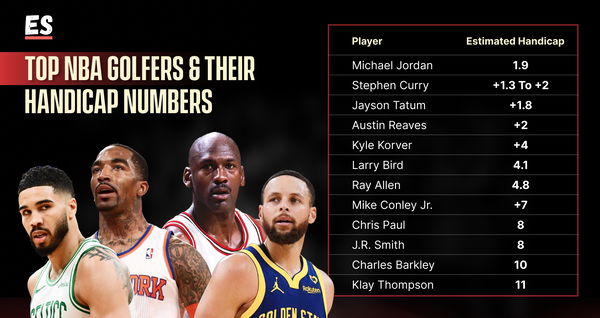
Imago
credits: Imagn

Imago
credits: Imagn
Golf versus basketball. Can the hushed greens really outshine the roaring hardwood? The shift is undeniable, and the evidence suggests yes.
Watch What’s Trending Now!
From Michael Jordan’s obsession with 36-hole days to Stephen Curry’s championship-level play to LeBron James embracing the greens, golf has become more than a pastime for the NBA’s biggest stars.
Because golf, unlike basketball, doesn’t end at 48 minutes. It’s slower, subtler, and social in a way basketball arguably never could be. It offers space. Space to build relationships, perhaps negotiate a few deals here and there. And, most importantly, the space to show personality beyond the hardwood, where perfection is out of the question and obsession is often loud…
ADVERTISEMENT
And almost confusing to a point where NBA stars might be pivoting towards it. Jordan’s Grove XXIII became a clubhouse for legends. Curry’s Underrated Golf Tour turned tee boxes into platforms for diversity. And LeBron’s latest outings signal that even today’s biggest stars see golf as a tool for longevity and branding, not just leisure. And that’s where the magic comes in.
Golf isn’t replacing basketball. Far from it, actually. It’s extending it. Every swing is content, every tournament appearance is influential, every green is another stage for the NBA’s biggest names to reinforce their dominance in culture. NBA stars are increasingly finding camaraderie on the golf course, creating connections that transcend their primary sport. As Curry puts it, “It’s a pretty special bond in terms of the basketball players who love golf.”
And while the world of golf would love for Stephen Curry to go pro, he has made clear where his priorities currently lie. However, to provide context on how we arrived at this point and why it matters so much in the first place, we’ll need to go back to MJ. Because, like everything Michael Jordan touches, the game of golf got cooler just by his association with it.
ADVERTISEMENT
Michael Jordan’s golf obsession and how it could’ve become an accidental blueprint
Michael Jordan’s passion for golf goes way beyond just a casual pastime—it shows us a deeper side of what drives him. Funny enough, the basketball legend once called golf a “sissy sport,” before it became his greatest challenge. In an exclusive with Stephen Curry, Jordan opened up: “But I kind of got into golf mainly because from a competitive standpoint to me, it is the hardest game… I can always respond to an opponent, a defensive guy, offensive guy, whatever. But in golf, it’s like playing in a mirror and you battling yourself consistently to try to get perfection.”
ADVERTISEMENT
This heart-to-heart between two basketball greats revealed something special—how golf tests your mind like nothing else. There’s something beautiful about how golf humbles even the world’s greatest athletes, forcing champions like Jordan to face themselves in ways team sports never could.
What began as curiosity transformed into an obsession through challenging teammates, pros, and, most importantly, oneself, by squeezing in 36 holes before tip-off and building his own course – The Grove XXIII, nicknamed “Slaughterhouse” for how brutally it humbled its guests.
Golf was never a distraction for MJ, but a second arena where his fire for competition ran unchecked. And the stories? They’re endless.
ADVERTISEMENT
Jeremy Roenick once recalled playing 36 holes with Michael Jordan, fueled by ten Bud Lights, only to watch him drop 44 points in an NBA game that very night. PGA names like Xander Schauffele admitted that MJ “beat me straight up.” And when Chuck Daly, then coach of the “Dream Team,” bashed him in a round?
Jordan famously demanded a 4 a.m. rematch. Because even in golf, losing was not part of his vocabulary. But what makes Jordan’s golf obsession so critical isn’t just the tall tales. It’s how public it all became…
Teammates, rivals, and even executives found themselves pulled into Michael Jordan’s world as he set the original playbook for what golf could mean to an NBA superstar, aka, a place to refine a swing instead of courting tabloid drama. To cement influence outside the hardwood, and to show the world that competition doesn’t end when the final buzzer sounds.
ADVERTISEMENT
And more than just making golf cool, he made it part of the NBA’s cultural DNA, so to speak. Jordan transformed casual off-court activities into statements of identity—golf became more than a pastime; it became a symbol of excellence beyond basketball. His Sunday morning tee times during playoff series weren’t just recreation but psychological warfare, displaying his unshakable confidence and mental fortitude.
When Jordan stepped onto the golf course in between championship games, he wasn’t escaping basketball—he was extending his competitive arena, showing that greatness transcends boundaries. This subtle fusion of elite flair with leisure pursuits created a template for NBA stars: your brand extends beyond the hardwood; your influence shapes culture itself.
So it was only fair that the template stuck. And speaking of the NBA’s cultural DNA, Stephen Curry did just that, and flipped it into a movement.
Stephen Curry and the golf escape
With a reported +1.3 to +2 handicap. A hole-in-one at the American Century Championship. And a clutch walk-off eagle to win the 2023 edition, Curry proved he wasn’t just dabbling. He was competing and winning on a stage packed with celebrities and ex-pros. “In both sports, when you find that flow… there’s no better feeling,” Curry once said, blurring the line between his two loves.
In a testament to his competitive spirit, Steph claimed the 2023 celebrity golf tournament title with a masterful walk-off eagle on the final hole—a moment that perfectly captured his grace under pressure. “I don’t do this for a living, so it’s something you dream about.” Curry reflected, “I’ve been playing in this tournament for almost a decade and now I’ve got some hardware to show for it. It’s pretty special.”
The stats and stories make it even clearer.

Curry believes himself to be a self-proclaimed “golf junkie.” He squeezes in around 40 rounds a year, trains with legit PGA coaches like Alex Riggs, and walks fairways with presidents and champions alike, including a round at Augusta National with Barack Obama. His right-hand man on the course is Jason Richards, often seen looping as his caddie.
And while reporters have tried baiting him into imagining a pro golf career, Curry’s reply stays grounded: “Life is good in the league. I’ll be all right.” Still, he admits, “It is beyond a passion. It’s like a duty almost.” That sense of “duty” is what makes Curry different.
He saw privilege firsthand, exclusive Charlotte clubs through his father Dell’s NBA status, and he saw the other side through his friend Will Lowery, a Black golfer who grew up with talent but without resources.
Over dinner in 2019, Lowery sketched a triangle on a napkin: kids start in golf young, lose interest as teens when access dries up, and only a lucky few make it to college scholarships or the pro tours. “You belong here in this sweet spot,” Lowery told Curry, urging him to use his fame to change the equation.
Curry, to his influence, didn’t hesitate. Sitting at a stoplight the next day, he turned to Lowery and said, “I’m all in.” From that conviction came Underrated Golf, launched in 2022.
The program identifies 96 junior golfers from underrepresented backgrounds, hosts them in four high-level tournaments across the country, and then selects the best to participate in the season-ending Curry Cup. Winners earn full exemptions into the American Junior Golf Association. Which, well, is a crucial stepping stone for those eyeing college scholarships or even the PGA/LPGA tours.
And if not anything, they walk away with golf’s other hidden perk: access to business and life opportunities that the game quietly guarantees. Curry has framed Underrated Golf as more than just charity. For him, it’s culture-building.
This mission shone brightly when Curry rang the Nasdaq opening bell, his Olympic gold medal gleaming amid swirling confetti. Pausing, hands to his face in gratitude, he was embraced by a young Underrated Golf Tour player—a quiet testament to the program’s impact.
The tour’s three-star logo, inspired by Curry’s own underdog journey as a three-star recruit, symbolizes limitless potential. After the ceremony, Curry Cup winners Jaden Soong and Izzie Kelly joined peers in Times Square, their images lighting up the seven-story MarketSite Tower. “This tour fills me with joy unlike any other,” Soong said in his 2024 victory speech, capturing the unique blend of competition and community that sets Underrated Golf apart.
Leveling the field for kids who might otherwise be shut out of country club gates. “With that privilege comes a responsibility,” Curry has said, “to assist others who need obstacles removed to have success in golf—and in life.” And that’s the difference…
Together, Curry’s on-course brilliance and off-course legacy work have elevated golf into something bigger than a celebrity hobby. So much so, Curry is now even trying to get Draymond Green involved in golf. So naturally, more NBA players had to step in. And step in they did, in style and authority, no less.
How the league followed golf as the NBA’s second language
From Hall of Famers to role players, golf has developed into the league’s unofficial second language. Part therapy, part pure obsession. Take Ray Allen, one of basketball’s most precise shooters, who now applies that same discipline to the course.

Back in 2021, Allen posted on Facebook about how lowering his handicap only raised his expectations. And, in turn, his frustrations. “When I was a 10 handicap I was happy if I found my ball… now I think I’m supposed to birdie every hole,” he wrote, before flipping it into a life lesson about perspective and disappointment.
Since retiring, the two-time NBA champion has proved just as clutch with a driver as with a corner three. He once torched Concord Country Club with a 7-under 63, holing out for eagle on a 438-yard par-4. “It should’ve been 61,” Allen joked later. Call it muscle memory from hitting one impossible shot after another.
Then there’s J.R. Smith, who turned his post-basketball restlessness into a full-on collegiate pivot. After leaving the NBA in 2020, Smith enrolled at North Carolina A&T and walked onto the golf team, averaging 85.58 in competition while simultaneously studying social sciences. Along the way, he crossed fairways with Jordan at The Grove XXIII and teed it up with pros like Dustin Johnson and Tony Finau.
What Smith discovered, like so many other ex-players, is that golf’s discipline humbles and humanizes superstars in ways basketball never could. Even players who can’t yet string together a clean swing have found their way into golf’s viral slipstream.
LeBron James’ awkward swing at a pro-am sparked a roast catalog of commentary. Shannon Sharpe joked, “Those shoulders are too tight.” Chad Johnson piled on: “Bronny should’ve booked his dad a lesson.” Joe Johnson offered encouragement, while Steph Curry added the punchline: “The game needs you, big fella.”
It was proof that in today’s NBA, even an ugly swing makes content, and golf has become a language every fan recognizes.
Charles Barkley, once a meme for the most tortured swing in sports, is grinding his way into redemption. Shaquille O’Neal, turning every pro-am into a charisma show, and the endless parade of stars who treat golf as their PR-friendly second stage.
Larry Bird carried a reported 4.1 handicap. Klay Thompson has become a fixture at celebrity events and is even getting his current girlfriend, Megan Thee Stallion, involved. And names like Chris Paul, Kyle Korver, Andre Iguodala, Jimmy Butler, Jayson Tatum, Devin Booker, Luka Doncic, Anthony Davis and Giannis Antetokounmpo.
Kobe Bryant was known to admire various sports, including golf, for their lessons in discipline and camaraderie. In a tribute following his passing, it was noted that he had a strong connection to multiple sports, including golf, and was remembered for his competitive spirit that could resonate with initiatives like Curry’s Underrated Golf.
This crossover runs deeper than culture. As Dr. Greg Rose of TPI points out, nine of the PGA Tour’s ten longest drivers grew up playing basketball. Thirteen of the top fifteen stand at least six feet tall, using their frames to generate lower moments of inertia and higher clubhead speeds.
In other words, the NBA has been unconsciously training golfers for decades. When you see Karl-Anthony Towns or Paul George smashing drives at a charity event, it isn’t a coincidence. The evidence is everywhere.
Locker rooms turning into swing labs, pro-ams packed with NBA stars, viral clips surfacing every summer. Golf is the NBA’s unofficial second sport, a canvas where legends and role players alike rewrite themselves. Jordan made it a flex. Curry made it a platform. And the rest of the league followed, turning the greens into basketball’s quietest, yet loudest, second stage.
ADVERTISEMENT
ADVERTISEMENT
ADVERTISEMENT

